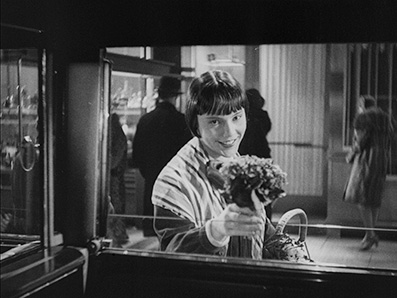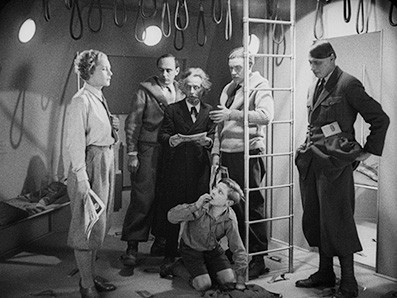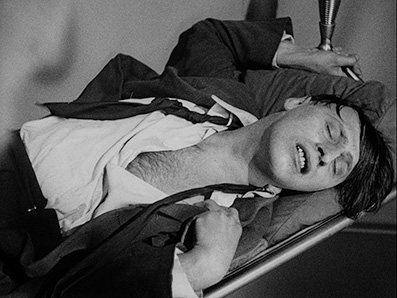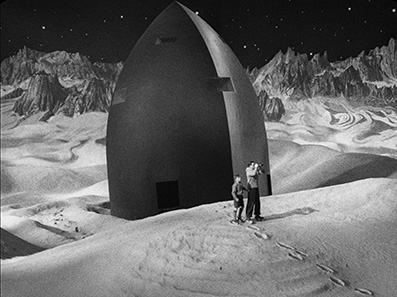|
There's a very particular and satisfying thrill that comes from watching a film in which fanciful technology of the filmmakers' invention has since come to pass. Not so long ago, this even became part of a mammoth court case, an expensive patent battle between computer hardware giants Apple and Samsung. If you've not read about this already you'll likely think I'm making it up, but I'm really not. In 2005, the two companies began another in a seemingly endless series of legal battles over patent infringements of their respective phones and tablets, and part of Samsung's case revolved around the idea that far from being new, the idea for Apple's iPad had been around since 1969, when it was seen being used by the Jupiter astronauts to watch news broadcasts from Earth in 2001: A Space Odyssey. Ergo, Apple's hardware patent should be deemed invalid because the company had apparently nicked the idea for this now ubiquitous piece of hardware from Stanley Kubrick. Unsurprisingly, perhaps, Judge Lucy Koh dismissed the claim. I'm eagerly waiting for Samsung to start waving clips of the Thunderbirds wristwatch communicators when Apple's much taunted iWatch finally appears.
Yet despite such legal silliness, watching 2001 again from a modern perspective does make the film's prediction on this score feel a little uncanny, although the effect is somewhat dampened by the archaic looking monochrome broadcasts still being transmitted to it by the BBC. Kubrick could envision a future in which iPads were used to watch TV, but not that those broadcasts might be in colour or HD. Well, nobody's perfect.
Fritz Lang's 1929 Frau im Mond. [Woman in the Moon] (the full stop is technically part of the title, so I'm going to leave it in) proved to be similarly forward looking, with some uncannily accurate predictions about the technical aspects of manned space flight, a real world achievement that at this point was still a good thirty years from being realised. So on the nose are some aspects that you could almost think that Lang and his team were planning an actual mission once the filming was completed. Mind you, if they followed the film's scientific reasoning through to the actual landing, they'd all have been dead in a matter of seconds. Here the moon's surface is shown as being akin to the Sahara desert, a place where you could pitch a tent and walk around in your everyday clothes without fear of suffocation or the effects of blood-freezing vacuum. At this point the film feels closer to Nick Park than Stanley Kubrick.
There is, however, an almost feature-length drama of relationships and industrial shenanigans to get through before we get to this lively science fiction adventure. It's a build-up peppered with the sort of exaggerated gestures, overlong dialogue exchanges and play-to-the-gallery performances we tend to associate with silent cinema, but is also layered with the sort of political intrigue and damning portrait of self-serving capitalists that illustrates just how little has changed in the intervening years. But I've covered all this some detail in my earlier review of the Masters of Cinema DVD release of the film, which you can read here.
So how does the Blu-ray version measure up?
This is one of those times where the age of the film, coupled with the high quality of the transfer of the previous Masters of Cinema DVD release, prevented me from setting my sights too high. How much better could a 1929 film look than it did before, particularly as this new release was sourced from the same F.W. Murnau-Stiftung restoration? Never underestimate what HD can tease out. First up, what was good and great about the DVD transfer is every bit as good and great here. The image is stable, the contrast punchy without swallowing up detail in darker areas, and previous damage has been effectively minimalised, though is unsurprisingly more visible here than it was on the DVD, particularly the verticle scratches. Dust spots remain throughout, but are rarely intrusive and there are whole sequences that have scrubbed up very well in this regard. As before, the film grain is very visible, more so in 1080p than it was on SD, but in a way that feels organic to the film rather than the result of enhancement, of which there is no obvious trace here. What has improved, as you would hope and expect, is the level of picture detail, which is immediately evident in the textures of clothing, furnishings and faces, and can be specifically identified at the end of the panning shot of the documents on Professor Manfeldt's wall – lettering that is an indecipherable blur on the DVD is clearly legible here.





Being a silent film, the soundtrack consists of a music score only, the same piano soundtrack from the previous release and sounding clear and full on the Linear PCM stereo track here.
The disc includes the same extra features as the previous DVD, and the descriptions below have been adapted from my review of that disc.
The First Scientific Science-Fiction Film (14:39)
A short but still thorough documentary on the film made by Luciano Berriatúa for F.W. Murnau-Stiftung and Transit Film in 2006. It's packed with interesting background detail on the production, with the information on Hermann Oberth and his working relationship with Lang (the advertising budget for Frau im Mond. was used partly to fund Oberth's design for the world's first liquid fuelled rocket) being particularly fascinating. The parallels between the film's moon mission and the real thing are examined by directly comparing the two, but the film's ending is revealed here, so this is definitely one for after the main feature. I may be mistaken, but this appears to be standard definition rather than HD.
Booklet
The main essay here is Frau im Mond. and the Fritz-Lang-Film – A Formal Analysis by Michael E. Grost, which is nowhere near as stern as that title makes it sound. Grost looks at the politics of the film and its use of media, clocks and shape symbolism, as well as its influence on director Edward G, Ulmer, he of the 1934 The Black Cat, something of a favourite on this site. A Frau im Mond. Casebook collects snippets from three critical sources, specifically Jacques Rivette, Lotte H. Eisner and Tom Gunning, and rounds off with a couple of quotes from Lang himself, the second of which is as amusingly idiosyncratic as the film itself.
This new dual format release, containing both the Blu-ray and DVD versions of the film and its single on-disc extra, is in line with a fair number of HD upgrades to previously released Masters of Cinema titles in that the 1080p transfer is the only thing that really differentiates it from the earlier DVD. Now we love Eureka Entertainment's Masters of Cinema catalogue with the sort of passion normally reserved for spouses and girlfriends (sorry, ladies), but I can imagine there are a few people out there who bought the film on DVD that feel just a little aggravated at being asked to buy the same film again a few years later with the very same extras and at a similar price, purely for an increase in picture sharpness and detail (that you also get the DVD version that you already own as part of the package must also smart a little). And they have a point, at least to a degree. But it's worth remembering that the DVD version of Frau im Monde. was released back in 2008, when Blu-ray was still doing battle for HD dominance with HD-DVD, and when precious few titles of note (that's me in my ever so slightly cynical mode) were available in either format, at least in the UK. Given that the DVD transfer was sourced from a high quality HD restoration from F.W. Murnau-Stiftung in Germany, there's an absolute logic to making it available on Blu-ray now that the format has been far more widely adopted. And for those of you old enough to remember when compact discs really started to take off, how many of those LPs you worked all those extra hours to buy did you repurchase on CD because the sound was clearer and was free of the scratches and crackle and records always seemed to pick up whether you played them or not?
It's a fact that not everyone who bought the DVD of Frau im Monde. will feel the need or desire to upgrade to the dual format version. Indeed, were I not working from review discs, I'd also by picky about which titles I'd repurchase on HD (my DVD collection still seriously outweighs my Blu-rays). Picture and sound quality are an important consideration, perhaps the most important, but they're not the only ones (a friend of mine once bought the DVD of Roan Johnson's Brick over the Blu-ray because the extra features were far superior), and there can be few film devotees who do not have multiple copies of favourite films on their shelves, as the DVD is superseded by the Special Edition, and then by the Blu-ray, and then the remastered Blu-ray with all the missing footage... In the case of some particularly well packaged discs (just about anything from Arrow would qualify here), I've gone and bought the retail version even though I have the review disc, because I consider the packaging to be a valuable extra feature in its own right.
Of course, six years on there is also a new potential audience for Frau im Mond., those who did not buy the previous DVD release, those still making their way through Lang's extraordinary back catalogue, and even those who've previously been nervous about the whole concept of silent cinema. And whether you're coming to the film for the very first time or looking to own the best currently available version, then it's nice to know that there's a package that contains both an HD and SD version of the film, and for less than the price some big studios charge for their Blu-rays alone. I'll admit that Frau im Mond. is some way from my favourite Fritz Lang silent (but then look at the competition...), but there is still a great deal here to be entertained and even excited by, and anyone interested in the development of science fiction cinema or the work of its director absolutely owes it to themselves to see it. Recommended.
|